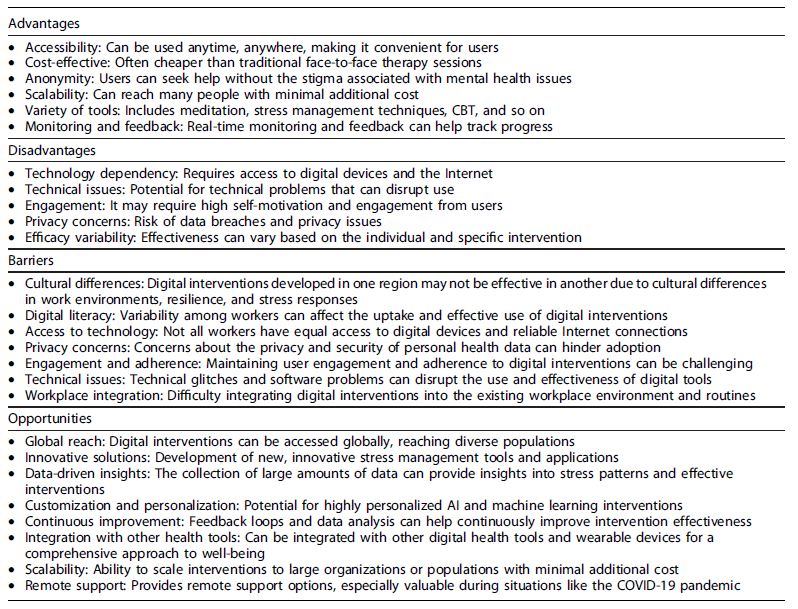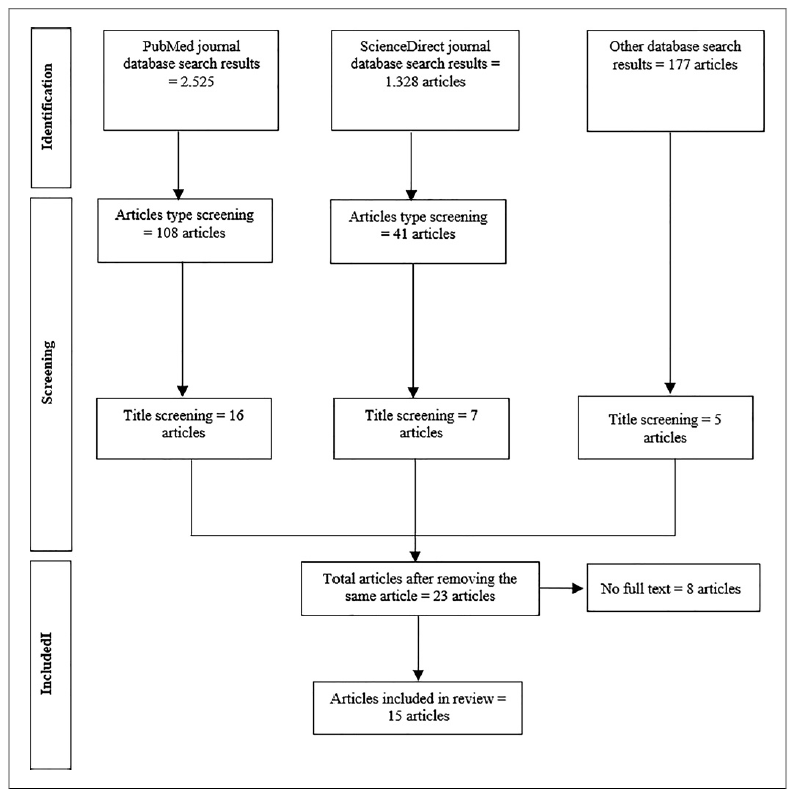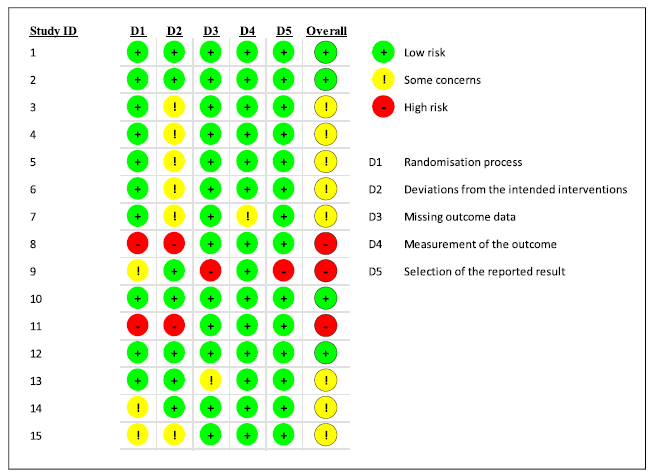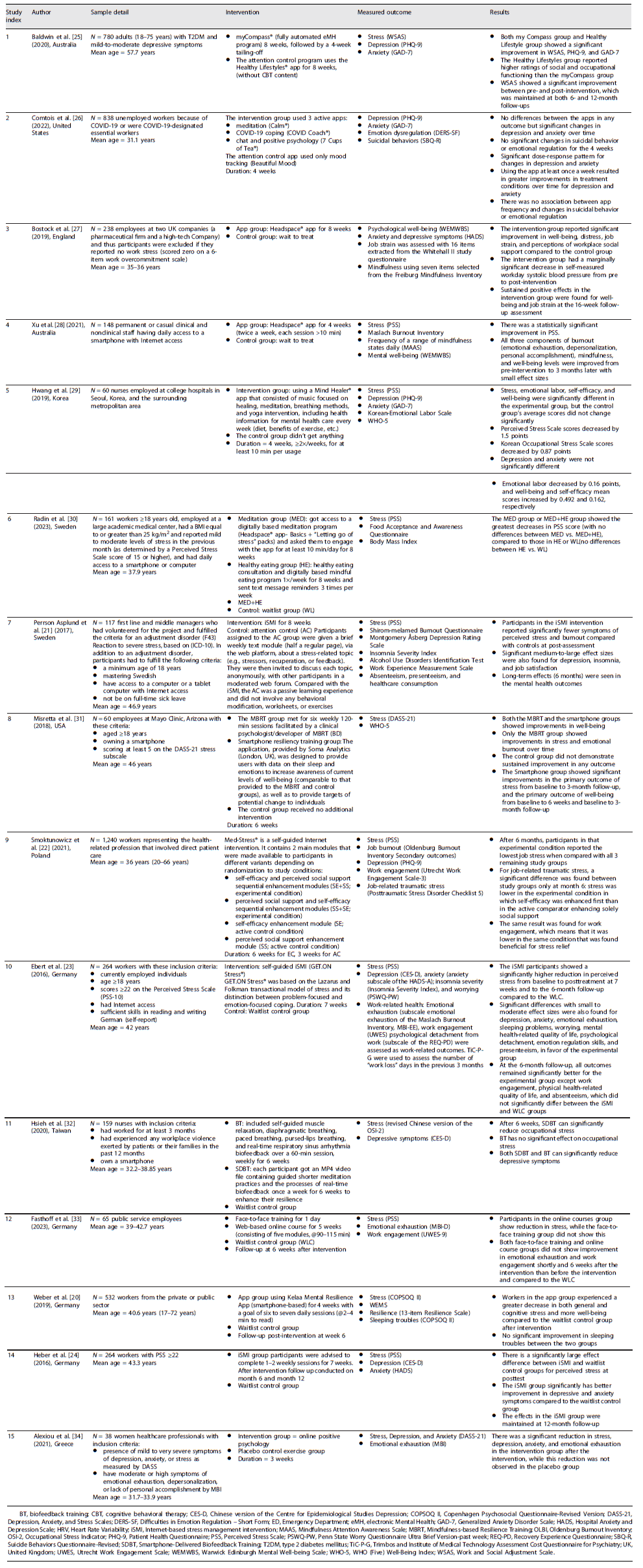Introduction
Occupational stress, characterized by psychological, physical, and behavioral responses to work-related demands that exceed coping abilities, is a global health problem impacting diverse professions 1-3. This pervasive issue has been the focus of numerous studies, revealing its detrimental consequences on worker health and organizational productivity 4 Prevalence studies shed light on the extent of occupational stress and its repercussions. In 2020, Salari et al. 5 found that 45% of front-line healthcare workers caring for COVID-19 patients experienced stress. Similarly, in 2018, Maharaj et al. 6 observed high prevalence rates of depression, anxiety, and stress, impacting Australian nurses. Furthermore, systematic reviews and meta-analyses, such as the 2021 study by Girma et al. 1, reported that healthcare professionals in Ethiopia faced a pooled prevalence of occupational stress at 52.5%. Similarly, Birhanu et al. 7, in 2018, noted that health professionals in Ethiopia endured workplace stress with a prevalence of 68.2%.
Occupational stress arises from several factors, with the nature of the occupation playing a pivotal role. In demanding fields like healthcare, high workloads, long hours, and a lack of social support contribute significantly to stress 1,8. The burden of excessive tasks and time pressure further exacerbates stress, as documented in a study of academic nurses 2. Inadequate resources, such as staffing shortages and insufficient equipment, amplify stress levels, placing additional burdens on individual workers 2. The absence of social support from colleagues and supervisors further complicates the coping process, intensifying stress levels 2. Rapidly evolving industries bring additional challenges, forcing workers to adapt constantly and cope with uncertainty 2. Work-life balance difficulties, particularly among those with long hours or irregular schedules, hinder personal responsibilities and self-care. In hostile environments characterized by workplace bullying and harassment, stress levels are intensified 9. The recent COVID-19 pandemic has exacerbated occupational stress, particularly among healthcare professionals, due to factors like a lack of rewards, social interaction, and support 3.
Occupational stress has far-reaching implications for job performance and outcomes, as documented by studies showing its association with burnout, decreased job satisfaction, and increased turnover intentions 2,10. Addressing occupational stress offers numerous benefits, including improved well-being, enhanced productivity, reduced turnover, a positive organizational culture, increased job satisfaction, improved safety, and enhanced teamwork 4,11-14. Digital intervention can help in reducing stress, improving mental well-being, and enhancing job performance 15-17. The flexibility, scalability, and personalization of digital interventions further enhance their appeal and effectiveness 18. By adopting digital interventions, organizations can promote well-being, reduce stress, and enhance productivity, contributing to a healthier work environment and increased job satisfaction. Ensuring the quality and evidence-based nature of these interventions is vital to maximize their impact. Analysis of the advantages, disadvantages, barriers, and opportunities of using digital interventions for occupational stress management is shown in Table 1.
However, despite the wealth of research exploring the sources and consequences of occupational stress, a significant research gap remains concerning the effectiveness of interventions in mitigating the detrimental effects of stress in the workplace. While we have identified the contributing factors and their associated stressors, there is a need to systematically assess the efficacy of interventions that address these factors and offer strategies to alleviate occupational stress. This systematic review aims to bridge this gap by focusing on digital interventions, including smartphone apps and websites, as accessible and scalable tools for stress reduction. By evaluating the current evidence from randomized controlled trials (RCTs), the review will provide insights into the effectiveness of these interventions in reducing occupational stress and improving worker well-being.
Methods
This systematic review was conducted following the Preferred Reporting Items for Systematic Reviews and Meta-Analyses (PRISMA) guidelines 2020 19. A detailed protocol was developed, outlining the research questions, search strategy, inclusion and exclusion criteria, data extraction methods, and quality assessment procedures. A systematic search was conducted across four electronic databases from the inception to May 2024: PubMed, ScienceDirect, Scopus, and Web of Science. Only studies in the English language were included. The following keywords were utilized: “Digital Intervention” OR “Mobile application” OR “Online Intervention” AND “Occupational stress” OR “Work stress” OR “Workplace stress” OR “Stress” OR “Workplace Well-being” OR “Mental health” OR “Mental Health at Workplace” OR “Job Stress” OR “Burnout” AND “Worker” OR “Employee.” The PRISMA flowchart is shown in Figure 1. The inclusion criteria for study selection were as follows:
RCTs published from the inception to May 2024.
Studies investigating the use of digital interventions, including smartphone apps and websites, for the reduction of occupational stress.
Studies measuring the impact of digital interventions on occupational stress reduction.
Written in English.
The exclusion criteria included the following:
Studies that are not RCTs.
Studies with populations outside the scope of workers or not addressing occupational stress.
Studies examine interventions other than digital interventions.
Study selection involves two reviewers who independently search and choose it from each electronic database. Cochrane risk of bias tool for RCTs was used to assess the risk of bias of the included studies. The study that has been collected is imported to the Mendeley Reference Manager version 2.91. Any discrepancies were discussed with a third reviewer to reach a consensus. Data about the first author, title, methodological data, and result data were extracted independently by two reviewers. The first author of the study was contacted to see if additional data was needed. Articles that did not directly measure or report relevant outcomes were excluded.
Results
After the initial search, a considerable number of articles were identified, exemplified by the retrieval of 2,475 articles from the PubMed database. To streamline the review toward observational studies, a filter specific to studies conducted after 2013 was applied, resulting in 1,233 articles meeting the criteria. Subsequently, a filter for RCT types was applied, denoted by the inclusion of the term “RCT” Publication Type. This screening process yielded 106 articles categorized as RCTs, aligning with the systematic review’s objectives. The comprehensive initial search ensured the inclusion of a diverse range of relevant literature, while the subsequent application of the RCT filter guaranteed the suitability of the selected articles. The 106 RCTs underwent careful assessment against inclusion and exclusion criteria to determine the final set of studies included, as illustrated in Figure 1 of the PRISMA flowchart.
In electronic databases, 24 articles with relevant titles to the eligibility criteria were discovered. After eliminating duplicates and conducting a full article review, 15 articles were included in this review. Exclusion criteria were applied to articles with relevant titles that did not provide a measurement of the relationship between variables. The study selection process is depicted in Figure 1 of the search flowchart. The included studies were conducted in diverse regions, including Germany (4 studies), Australia (2 studies), the USA (2 studies), Sweden (2 studies), and one study each in England, Korea, Greece, Poland, and Taiwan. A total of 4,964 workers were recorded from the included studies. The mean age of subjects ranged from 31.1 years to 57.7 years, with seven studies having a mean age of less than 40 years, eight studies with a mean age of more than 40 years, and the remaining study lacking information on the mean age of participants. The highest worker age was 72 years recorded from the included studies conducted by Weber et al. 20 in Germany. In general, this review mostly focused on workers aged 30-50 years, limiting the coverage for workers with age more than 50 years.
The assessment of risk across the included studies revealed varying degrees of methodological quality. Utilizing the Cochrane risk of bias tool for RCTs, it was found that 4 out of the 15 studies demonstrated a low risk of bias, while 8 studies raised some concerns, and 3 studies presented a high risk of bias. Specifically, concerning aspects such as the randomization process and deviations from intended interventions, 2 studies were flagged with a high risk of bias. Additionally, one study exhibited a high risk of bias related to outcome data and selection of the reported result. However, notably, none of the studies were deemed to have a high risk of bias in the measurement of the outcome domain. The risk of bias assessment is summarized in Figure 2.
Table 2 summarizes the findings from the included studies. Various instruments were employed to measure occupational stress in the reviewed studies, with the Perceived Stress Scale (PSS) being the most frequently used, utilized in eight studies. Following closely was the Patient Health Questionnaire 9 (PHQ-9) in three studies, and the Generalized Anxiety Disorder Scale 7 (GAD-7) and WHO (Five) Well-Being Index (WHO-5) in two studies each. Of the 15 included studies, all studies demonstrate a significant benefit in reducing occupational stress using digital interventions. Furthermore, insights gleaned from the included studies indicate that the positive effects on workers’ mental health persist for a considerable duration after the cessation of the intervention. Specifically, findings suggest that these effects endure for periods ranging from 3 to 12 months post-intervention. Notably, the majority of studies (4 studies) demonstrated that the positive effects persisted for up to 6 months following the conclusion of the intervention period 21-24.
The duration of interventions ranged from 3 to 8 weeks, with the majority (9 studies) implementing interventions lasting 6-8 weeks 21-25,27,30-32. Additionally, the frequency of interventions varied across studies, with some interventions requiring 20 min per week (3 studies) 20,28,29, while others necessitated 45-60 min per week (3 studies) 23,30,32, and two studies implemented interventions requiring 2-3 h per week 21,33. This variability in duration reflects the flexibility in designing interventions to suit different study contexts and participant needs. Moreover, all included studies implemented digital interventions that could be carried out at home or workplace, demonstrating their flexibility. However, most studies require the sample to have the ability to use technology as inclusion criteria. Regarding the types of workers involved, the studies encompassed a diverse range of occupational settings. Notably, seven studies focused on healthcare workers, highlighting the relevance of stress management interventions in this sector 22,27-29,31,32,34. Other studies involved workers in community settings, hi-tech companies, and academic centers, underscoring the broad applicability of digital interventions across various work environments.
In terms of platform usage, smartphone-based digital interventions were predominant, being utilized in eight studies 20,26-32. This prevalence may be attributed to the accessibility and convenience offered by smartphones, aligning with the modern workforce’s reliance on mobile technology. Among smartphone applications, the Headspace® app emerged as a popular choice, featured in three studies, possibly due to its being able to be downloaded for free, user-friendly interface, and great functionality for stress management. The digital interventions employed a range of stress management methods, reflecting the multifaceted nature of addressing occupational stress. These methods included meditation, educational materials, positive and motivational content, coping stress management techniques, relaxation techniques, and nutritional and exercise content. Additionally, several applications integrated cognitive-behavioral therapy features to tailor interventions to individual circumstances, enhancing their effectiveness and relevance. Despite the diversity of stress management methods utilized, certain approaches were more commonly employed across the included studies. Specifically, meditation 26-30,32, coping stress management 21-23,25,26,31,33, and nutritional and exercise content 21-23,25,29 emerged as the most frequently utilized methods. This highlights the importance of incorporating holistic approaches to stress management, addressing both psychological and physical aspects of well-being in the workplace.
Discussion
The findings from the included studies underscore the significant effectiveness of digital interventions in reducing occupational stress among workers. Across the included studies, digital interventions demonstrated consistent benefits, with all studies indicating a notable reduction in occupational stress levels. The utilization of standardized measurement tools is paramount in accurately assessing work-related stress, depression, and anxiety within occupational settings. Among these, the PSS emerges as a particularly valuable instrument for quantifying perceived stress levels among workers. Its widespread adoption in research settings facilitates comparability across studies and enables a comprehensive understanding of the prevalence and impact of occupational stress 35-37. Additionally, the PHQ-9 is an effective tool for screening depression symptoms, offering a structured approach to identifying individuals who may require further assessment or intervention 38,39. Similarly, the GAD-7 plays a crucial role in evaluating anxiety symptoms, providing valuable insights into the prevalence and severity of anxiety disorders among workers 40,41. Overall, integrating PSS, PHQ-9, and GAD-7 into occupational health assessments represents a proactive approach to addressing mental health concerns in the workplace and fostering a supportive and resilient workforce.
Digital intervention plays a pivotal role in mitigating occupational stress through diverse mechanisms. A comprehensive analysis and synthesis of Internet-based psychological interventions administered in workplace settings revealed that digital mental health interventions can enhance employees’ psychological well-being and boost work efficacy 42. These interventions typically offer guidance within a condensed timeframe, employ alternative delivery methods like emails and text messages, and integrate features of persuasive technology, such as self-monitoring and customization, which may foster increased engagement and adherence 42. Furthermore, digital interventions have demonstrated effectiveness in reducing occupational stress levels among nurses 43. The varied duration and frequency of interventions, ranging from 4 to 8 weeks and encompassing different time commitments per week, suggest flexibility in intervention design while maintaining efficacy. The prevalence of smartphone-based interventions highlights the accessibility and convenience afforded by mobile platforms in delivering stress management support to workers. Importantly, the observed persistence of positive effects on workers’ mental health for up to 3-12 months post-intervention, with the majority of studies indicating effects enduring for up to 6 months, emphasizes the enduring impact of digital interventions beyond the intervention period. By incorporating evidence-based digital interventions into their workplace stress management strategies, employers can proactively address occupational stress. Such interventions have the potential to reduce absenteeism, increase job satisfaction, enhance employee engagement, and improve overall productivity. Furthermore, these interventions provide flexibility, scalability, and personalization, allowing organizations to tailor stress management approaches to individual needs, and fostering a more supportive work environment. Investing in infrastructure, digital literacy programs, and organizational support can facilitate the successful implementation of digital interventions as part of comprehensive workplace health promotion strategies in the region. By embracing digital interventions, organizations can promote worker well-being and, in turn, create a healthier, more harmonious, and more efficient work environment while simultaneously supporting employees in coping with the challenges of modern work life.
Several key components contribute to the success of digital interventions in reducing occupational stress. First, most countries included in this review share similar characteristics regarding data consumption and literacy concerns. All included studies are from countries with an Internet adoption rate of more than 90% of their total population, with Greece and Poland being the exceptions at around 87% 44. These rates are considerably higher than those in low-income regions such as Eastern Africa (26%), Middle Africa (32%), Western Africa (42%), Southern Asia (51%), and Southeast Asia (71%) 44. Additionally, the literacy rates in the countries included in our review are notably high, exceeding 90%, whereas many African and South Asian countries have literacy rates around 70% 44. This emphasizes the critical role of Internet adoption and literacy rates in ensuring the successful implementation of digital interventions. Craig and Moe-Byrne underscore the importance of tailoring organizational interventions to cultural contexts, noting that interventions that are sensitive to the cultural and organizational environment are more likely to be successful. This is particularly relevant to our findings, as the positive effects of digital interventions observed in country with high Internet adoption rate settings may not directly translate to low Internet adoption rate country without appropriate cultural adaptation 45. The content diversity and customization options offered by digital platforms allow for tailored interventions that address the specific stressors and needs of individual workers. Commonly employed stress management methods, such as meditation, coping stress management, and nutritional and exercise content, underscore the importance of holistic approaches in addressing occupational stress. Additionally, the incorporation of cognitive-behavioral therapy features enhances the adaptability of interventions, enabling workers to identify and implement strategies that resonate with their unique circumstances. Moreover, the duration and frequency of interventions, which varied across studies, suggest that interventions can be effective within flexible time frames, accommodating diverse work schedules and commitments. The widespread utilization of smartphone-based interventions, particularly those utilizing popular applications, highlights the accessibility and user-friendliness of mobile platforms in delivering stress management support to workers. Overall, the integration of diverse stress management techniques, customization options, and mobile accessibility emerges as key components that contribute to the success and effectiveness of digital interventions in mitigating occupational stress.
While the findings from the included studies demonstrate the effectiveness of digital interventions in reducing occupational stress, it is essential to acknowledge potential barriers to their implementation, particularly in diverse cultural contexts such as Southeast Asia, South Asia, South America, and Africa. This lack of representation from the region raises concerns about the generalizability, where cultural norms, work environments, and worker resilience may differ significantly from those in the included studies region. The positive effects observed in the included studies may not necessarily be applicable directly to other regional settings, necessitating further research to validate these findings in culturally diverse contexts. Moreover, differences in technological infrastructure, access to digital devices, and Internet connectivity may pose additional challenges to the widespread adoption of digital interventions in other regions not represented by included studies. This review also predominantly focused on workers aged 30-50 years, limiting the coverage and insights for workers over 50 years of age. Therefore, future research should focus on adapting and validating digital interventions for other regional workplaces and other age groups, considering cultural nuances and contextual factors to ensure their effectiveness and relevance in diverse cultural settings. Most studies also require the sample to have the ability to use technology as inclusion criteria, which is not representative of workers who do not have access to ICT technology.
Looking ahead, it is imperative to address the gaps identified in this review. One of the primary limitations of this review is the high heterogeneity observed among the included studies. Variations in study designs, intervention types, outcome measures, and participant characteristics contribute to heterogeneity, potentially impacting the synthesis and interpretation of findings. Additionally, the limited representation of studies from Southeast Asian contexts, including Indonesia, may restrict the generalizability of results to this region.
In summary, this systematic review offers compelling evidence of the efficacy of digital interventions, such as smartphone apps and web-based programs, in reducing occupational stress among workers. The consistent positive outcomes and the adaptable nature of these interventions make them valuable tools for promoting worker well-being and creating healthier and more efficient work environments. This systematic review underscores the positive impact of digital interventions on reducing occupational stress. As workplaces continue to evolve, the integration of these evidence-based interventions holds great promise for the well-being of employees and the overall productivity of organizations. By prioritizing worker health and providing accessible and scalable resources for stress management, organizations can significantly contribute to a healthier, more harmonious, and efficient work environment in a dynamically changing professional landscape.
Conclusion
This systematic review provides evidence of the significant effectiveness of digital interventions in reducing occupational stress among workers. The findings highlight the diverse range of interventions, including smartphone-based applications and web-based programs, which have demonstrated positive impacts on worker well-being across various occupational settings. Moreover, the observed persistence of positive effects on workers’ mental health underscores the enduring impact of digital interventions beyond the intervention period. Further research is warranted to validate the effectiveness of digital interventions in culturally diverse settings and to explore their applicability and feasibility in Southeast Asian workplaces. Collaborative efforts between researchers, policymakers, and industry stakeholders are essential to tailor interventions to local contexts and maximize their impact on worker health and well-being.
Statement of Ethics
This systematic review did not involve collecting or analyzing primary data involving human subjects. The study solely focused on synthesizing existing literature from randomized controlled trials (RCTs) to evaluate the effectiveness of digital interventions in reducing occupational stress. As such, ethical approval was not required for this research. As this study did not involve the participation of human subjects or the collection of individual data, consent was not applicable. All data used in this systematic review were obtained from publicly available sources and published studies. Any identifiable information regarding individuals was anonymized in the included studies to ensure confidentiality and privacy.
Conflict of Interest Statement
The authors declare no conflicts of interest related to this systematic review.
Author Contributions
The author’s contributions to this manuscript were as follows: Bima Indra, Valie Palmasutra, and Febry Afrianto Setyawan contributed to the study’s conceptualization. Design and methodology were primarily handled by Bima Indra and Valie Palmasutra. Bima Indra and Valie Palmasutra carried out data collection. Bima Indra and Valie Palmasutra conducted data analysis and interpretation. The initial writing and drafting of the manuscript were primarily the responsibility of Bima Indra, while critical revisions were made by Valie Palmasutra and Febry Afrianto Setyawan. Febry Afrianto Setyawan provided supervision throughout the project. All authors reviewed and approved the final version of the manuscript before submission.


















